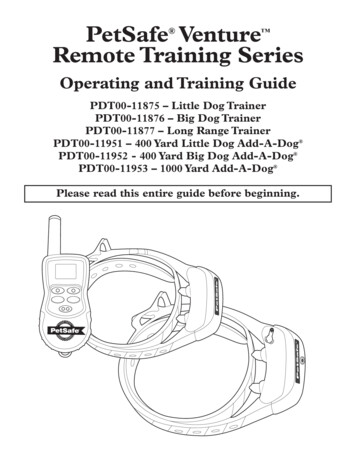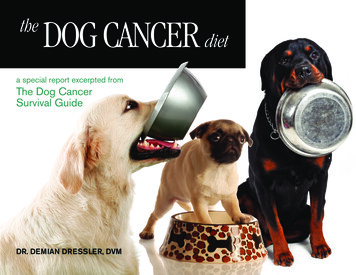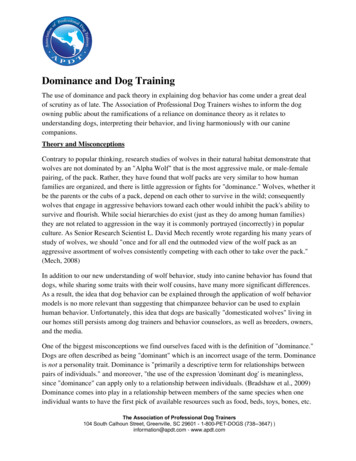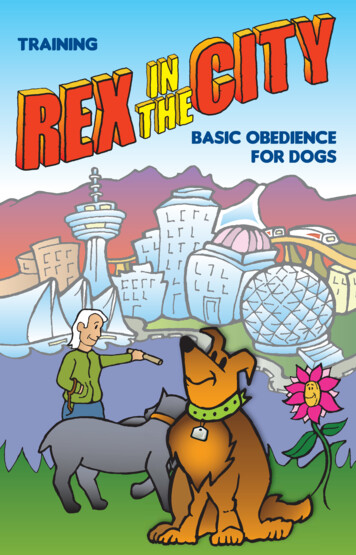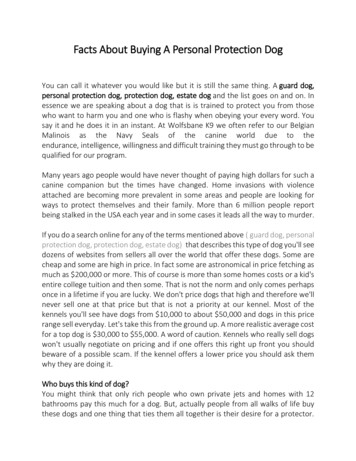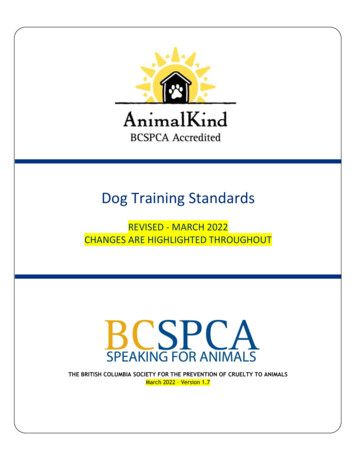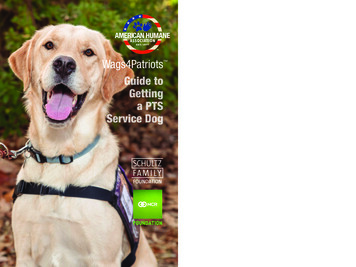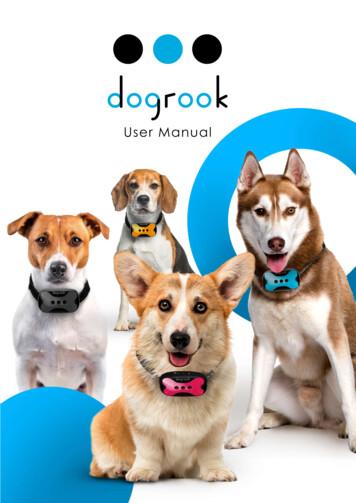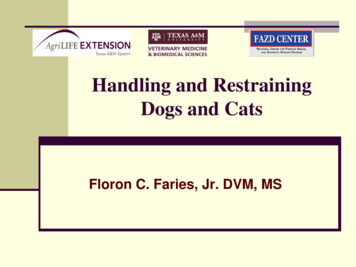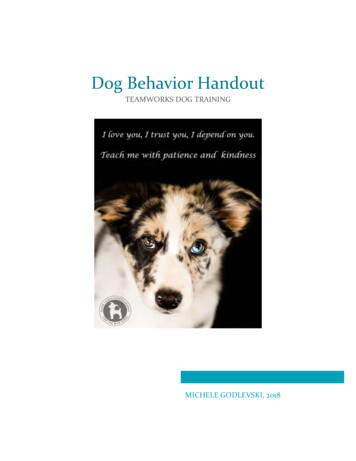
Transcription
Dog Behavior HandoutTEAMWORKS DOG TRAININGMICHELE GODLEVSKI, 2018
What Does it Mean to Be a Leader?Believe it or not, in the dog world, the most important trait a leader has is NOT that the leader isthe biggest or strongest .but that a leader controls all the resources. This means a leader is incharge of food, water, attention, resting spaces, and the general agenda for the pack. Of course,the best human leaders are the ones we respect and trust not the ones we fear. So, when you setout to be your dog’s leader, remember that it doesn’t mean you need to “dominate” your dog.You simply have to prove that your dog needs to work for its share of resources, and that you arefair and trustworthy. You can start by making your dog work for its food, instead of just putting it in a bowleach day. Dolphin trainers do this too. They measure out each dolphin’s ration of fishfor the day and use that bucket of fish for training sessions. Whatever is left at the end ofthe day is fed to the dolphin for its dinner. Of course, in order to do this with your dog,you need to be sure food is not left out in a bowl for the dog to free-feed all day. Instead,put a day’s worth of food in a zip-lock baggie, and use it for training sessions throughoutthe day. Whatever is left at the end of the day can be fed to your dog as dinner. Thispractice will also help your dog maintain an ideal weight, and not have any gastrointestinal issues from varying the diet too much. Dog leaders also choose the space they rest in. This means you should be able to specifywhere you dog sleeps or rests ( a crate, an exercise pen, or a dog bed), and be able to haveyour own resting space to yourself if you desire. In order to help your puppy with thisconcept, be sure to feed your dog his remaining dinner in his crate or exercise pen or dogbed. You can also give him any bones in this space. Dog leaders choose the agenda and provide rules and boundaries. Your dog will feel alot more secure if he knows that there is a routine for the day and a general schedule tofollow. Dogs like to know what to expect, and prefer consistency. In general, when youare training a puppy or a new dog, less space means more control over behavior. Don’tgive your puppy or new dog free reign of the entire house. Just like a child in school hashis desk or his locker, or his room at home your dog needs some boundaries so he learnsto earn more freedom gradually. Play with your dog needs to have structure too. Leaders don’t chase their dog around.Leaders start games and end games. For more information about this, see our handoutcalled Good Games to Play with Your Dog. Meet demands with demands If your teenager demands spending money, do you at leastdemand they clean their room first? The same should be true for your dog. If your dogdemands to be petted or played with, ask for a sit first.RECOMMENDED READING: Learn To Earn by Dr. Sophia Yin & Leader of thePack by Dr. Patricia McConnellPAGE 1
JUMPING UP ON PEOPLEWHY DO DOGS JUMP UP? Dogs jump up to get close to your face to smell you breath. Your breath gives your dog information on where you have been and how you are feeling. The urge to jump is worse when the dog feels separation anxiety.COMMON OWNER MISTAKES: Petting the dog or holding the dog when she jumps up. Allowing the dog to jump up on you but scolding her for jumping on others. Allowing dog to jump up on bed or on couch whenever she pleases without invitation . Using the word "down" for two different things -- when you mean "don’t jump up" and when youactually want the dog to lie down. Making a really big fuss over the dog during greetings.START BY: Stop petting the dog for jumping up. Make sure your family members and guests do the same. When your dog jumps up she should get no eye contact at all and no petting or hands on the dog. If the dog jumps up, say "off" and turn completely around and deny your dog face and hand contact. Say "sit", and when the dog does, reward her by crouching down to put your face at her level. Pet the dog calmly only if she remains in a sitting position. Begin a routine of always asking the dog to sit or lie down before petting her. Don’t make a big deal over leaving the house or returning. Although you may have missed yourdog, keep your greeting calm. Crate dog when you are not home. Make her sit before letting her out of the crate. Follow samerules if she jumps up after letting her out. If the dog is kept outdoors, make her sit before you enterthe pen. If she continues to bark and jump in her pen quietly turn around and disappear out ofsight. Come back when she stops barking. Practice this routine often. Please note, however, if your dog feels isolated and ignored, she will not only want to jump up, but she will exhibit othersigns of separation anxiety like destructive chewing, howling or excessive barking. Remember that dogs are pack animalsand crave companionship. If the dog is truly jumping out of lack of attention, you will need to also spend quality time withyour dog every day, enroll your dog in Doggie Dasychool, and/or to get her aplaymate. If the dog is allowed up on furniture and beds (i.e. near people's faces) without invitation, she willbe much more likely to jump up to obtain this familiar vantage point. If you are having jumping upproblems on furniture, stop allowing the dog free reign of the house and use a crate, exercise pen,or baby gates. Teach the dog only to come up when you ask her to do so. Teach your dog to go to a dog bed or “station” when the doorbell rings. You can then throw abunch of dog food or treats onto that dog bed. Practice this a home repeatedly, until your dog runsto her dog bed when she hears the doorbell ring.RECOMMENED READING: The Toolbox for Building a Great Family Dog by Terry Ryan.PAGE 2
MOUTHING PEOPLEWHY DO PUPPIES AND YOUNG DOGS MOUTH PEOPLE? Puppies are supposed to play with other puppies and dogs – in a mouth-on wrestling style – untilthey are about a year to 18 months of age. This is normal behavior for them. When we takepuppies away from their littermates, they are usually very deprived of canine interactions, unlessyou have another youthful dog in the household. For this reason, doggie daycares have becomevery popular. Puppies are not just “playing” when they mouth each other. They are learning something called“bite inhibition”. In other words, they are learning muscle-control for their jaws. If they biteanother puppy or dog too hard, the other puppy or dog will give them feedback and will stopplaying with them. This lesson is best taught by another dog, not by a human.COMMON OWNER MISTAKES: Allowing the dog gnaw on humans when he is a puppy. Some people in the house allow the dog to gnaw, others don’t. Rough-housing with the dog, using your hands as a toy.START BY: No more rough-housing or wrestling games. Use a toy in the dog’s mouth at all times during play.Teeth on skin GAME OVER. Follow all rules of leadership (see Leadership handout). Make dog sit or lay down to earn alltreats, meals, or toys. Enroll your dog in our Doggie Dayschool or a quality (versus quantity) small-play-group doggiedaycare. Dog Parks are not recommended because of the large numbers and inconsistency of theplay groups. Set up play dates with well-matched dogs belonging to neighbors, family, and friends. Find (and keep handy) an acceptable chew toy and give it to the dog. Make sure you haveseveral different types of toys placed all around the house. Hand it to the dog and praise ifhe starts to chew on the toy. Repeat above if he chooses to chew on you again. Be verystubborn about doing this routine over and over again. Do not allow your dog to gnaw onyou or others "sometimes". When he persists in gnawing on you rather than the toy, call a time out. Get up off the floor. Takethe toy andwalk away from the dog. Removing your presence will give him the message that teethon skin is game over. Let him know exactly where the fun stops.RECOMMENDED READING: After You Get Your Puppy by Dr. Ian DunbarPAGE 3
GROWLINGWHY DO DOGS GROWL? Growling is used by dogs as a warning. A growl means “stop what you are doing or I might haveto bite you”. NEVER punish a dog for growling, especially if you have children. That growl letsyou know you need to stop what you are doing and go see what is going on! Dogs sometimes growl over territory – you, their house, their yard, their food, their toys. Puppies and young dogs often growl at something they find to be different or scary. If your dog growls at strangers, you may think that is a good thing for protection, but whatif he growls at your neighbor’s child? Chances are, if your dog growls at just any stranger,your dog may pick the wrong person to growl at. You do not want a dog that cannot tell thedifference between a real threat (someone breaking into your house) and the mailman. Do NOTencourage your dog to growl at any person. Puppies and young dogs need to know that the worldof people is a safe place. All dogs will bark when they hear a noise that is all you need to letyou know someone is outside your door. If your dog growls at other dogs, his intent is probably to tell them to stay away from histerritory or his things. Be sure you are feeding dogs from the same household in separate spaces,out of sight from each other. Dogs do NOT like to share their food or bones with other dogs, inthe same way that kids really prefer their own rooms.COMMON OWNER MISTAKES: Petting the dog as it growls, saying “its alright”. (This reinforces the behavior and tells the dog tokeep doing it!) Encouraging the dog to growl at strangers. This is NOT a safe practice. Just because a person isnew to your door doesn’t mean they aren’t welcome, unless you never plan to make any newfriends.START BY: If your dog is growling at another dog, he is getting reinforced by WATCHING THE OTHER DOG’S REACTION (the other dog squirms or runs away). The way to stop his reinforcementis to break his eye contact with that dog and give the dogs separate spaces to eat or chew bones in. To prevent growling at the wrong person, teach your dog the word “friend” by saying theword everytime someone he likes comes to visit. Praise him while you say “friend” and makesure that person pets the dog and gives him treats. Then, when your neighbor’s child wantsto pet your dog, say “friend” and have that child give the dog treats and pet him. He willthen understand that the word “friend” means that person is o.k. with you. If you don’tmake this clear for him, he may make his own conclusions. (Also, now when there is a knock onthe door, you can open it up and tell your dog “friend” when it really is a friend.)RECOMMENDED READING: The Sentry Dog by Michele GodlevskiPAGE 4
CHEWING ON INAPPROPRIATE ITEMSWHY DO PUPPIES AND YOUNG DOGS CHEW THINGS UP? Puppies have baby teeth until about 5 months of age. However,their adult teeth will still grow and not be fully in place for another7 months. When dogs are “teething”, it feels good to chew onthings. Puppies also explore the world with their mouths. They areconstantly testing things to see if they meet the criteria of “yummyfood”. Some puppies and young dogs chew on items because they getattention (even negative attention) for doing so.COMMON OWNER MISTAKES Allowing a puppy to chew on an “old shoe” or “old towel”. Firstof all, those materials are not designed to be chewed on. Secondly,a puppy cannot tell the difference between an old shoe or toweland a new one. Yelling at and chasing the dog when he steals an item he is notsupposed to chew. This just makes stealing fun for your dog.START BY Teach your dog a “drop” or "release" . Have two identical toys for a play session. Throw one.Show the dog the other and wait until he drops the first. As he does, say “release” and throw thesecond toy. Practice giving him a toy, then releasing it for a treat. Crate your dog when you are not home or use an exercise pen or baby gate to confine him to asmall area. CRATING YOUR DOG IS NOT ANY MORE CRUEL THAN PUTTING A BABYIN A PLAYPEN.AND IT MAY SAVE YOUR DOG'S LIFE. Let your dog earn his freedom inthe house by displaying good behavior, maturity, and self control. Most puppies that learn to gointo a crate not only grow out of the need to be in the crate, but also will readily go into the crateto sleep without being told. Get a separate "box" to store all of dog's toys in. Do NOT allow dog to chew on "old" shoesor socks. Limit his toys to exclusively “dog” toys and keep all other household items inunreachable places. You can coat items that you DO want the dog to chew on with beef or chicken fat. To help himmake the distinction, spray the items you do NOT want the dog to chew with lemon juice, cayennepepper, Bitter Apple (available in pet stores), or Capsaicin roll-on. Keep a variety of chewable dog toy items in the "dog toy box". Good chewable toys includeKong toys, Nylabones, bully sticks, pig ears, all-cotton knotted rope toys, pressed American-maderawhide (in very limited quantities). Dangerous toys include rawhide chips, non-cotton ropetoys, toys with easily removable squeakers, ham or poultry bones or splintery bones. When indoubt about a toy, always follow the advice of your veterinarian or breeder. Certain toys may notbe safe for certain breeds of dogs because of their size or composition.RECOMMENDED READING: Take Control, But Don’t Lose Control, by Michele GodlevskiPAGE 5
NOT COMING WHEN CALLEDTaking the keys away and going back to driver’s education trainingMany new dog owners (and especially new puppy owners) allow their dog the freedom of being off leashbefore the dog is really ready. While most young puppies naturally cling to their owners out of insecurity,most adolescent dogs will choose a squirrel, cat, or other dog over returning to their owner. If you take yourdog off leash before he has been taught a recall with distractions, your dog is likely to learn that it is morefun not come to you, and worse yet, to end up getting hit by a car. Essentially, it Is like giving the car keysto a 13-year-old and saying “Go ahead! Drive as fast as you want and have fun!”. Instead, your dog shouldbe taught to come to you and then systematically introduced to distractions before you ever take the dog offleash, especially in an un-fenced area. Think of it as driver’s education training.Have you ever caught your dog misbehaving and then said "Come over here right now!"?If so, your dog only remembers that you called him, and when he came to you, he got punished. Your dogprobably has no recollection of the what he did wrong because you re-focused his attention from what hewas doing to you. You will need to choose a new recall word, because your dog probably learned very wellnot to come in response to the original one. The next time your dog misbehaves, go over to him and givehim a verbal reprimand right at the place of wrongdoing. Focus your efforts on the actual “thing”the dog was doing (i.e. the trashcan if he was getting into the trash) so the dog associates the feedback withthe item and not with you. Of course, you will also need to train an incompatible behavior to what the dogwas doing or manage the situation differently to prevent the problem. But the bottom line is not to ask thedog to come to you when he is doing something wrong.When you call your dog does he run the other way? Do you chase him? Does his tail wag?Dogs like this think "come" means "Chase me! Let's have fun!". You will need to choose a new recall wordand teach it properly. This process will be most successful if you stop the practice of letting your dog runfree and always keep a lead attached to him. Chasing him only cheapens you in his eyes and underminesyour authority as the "leader". Let your dog EARN the right to run free by first LEARNING the recallproperly. Test him on a long loose leash before ever taking the lead off. Also, make sure there are bigPAGE 6
rewards given for coming back to you or coming inside – keep a supply of treats and toys handy by thedoor.Does your dog bolt out of the car? The house? To his food bowl?Start today and make a ritual out of always requiring the dog to sit and stay and be released before he isallowed to go in or out of the car or house or get his food or a treat. It may seem regimented, but if youwant results, you need to remember that you need to control the food to be a leader.Be honest. Does your dog really get all of the exercise he needs for his breed and his age?Do you know what it feels like to be cramped up in a small space like a car all day? Now imagine a twoyear old child cramped up in that space. What happens when they finally get out into some fresh air? Youmay be tired when you come home from work, but your dog is has “cabin fever” and ready for action.Remember also, that your dog has been genetically selected for thousands of years to perform a task. Whatis that task for your breed? Herding sheep all day? Retrieving water fowl across large ponds and throughlots of tall weeds? You would be surprised how much of a difference it makes to have 15 minute, intense,running or play sessions with your dog in the morning and in the evening. Make time for him and he willrespond. Tire him out and he’ll be less likely to want to convince you to run after him.What will happen if you just let your dog run free in the neighborhood?Statistically, he will probably be stolen, poisoned, abused, attacked by other dogs, or hit by a car. There is aleash law in Wake County -- if you are lucky, he will get picked up by animal control before he is harmed.Remember, dogs are 14,000 years of breeding away from wolves. The reason they do not fare well "in thewild" is that dogs were selected for their puppy-like nature and trust of human beings. Wolves do not trusthumans instinctively and do not follow cars or try to seek humans out. We domesticated dogs away fromwolves and it is our responsibility to make sure that dogs are protected in our urban and suburban societies.Remember that a male dog can smell a female in heat up to five miles away through brick, plaster, or wood.If given the option, he will run to find her, following only his nose and leaving all common sense behind.Dogs bred to hunt will do the same after small game. When your dog roams the neighborhood, hewill consider the whole thing to be his “territory”, which will lead to other problems like fighting with otherdogs, chasing or killing small animals, chasing cars, and aggression.How should you train your dog to come to you?Don't let the "recall" just happen; anticipate the situation and set your dog up to succeed. Stuff your pocketswith treats or toys. Attach a long piece of rope or Flexi lead to your dog and let him think he is runningaround free. Discreetly pick up the end of the rope and call your dog. Back up slightly. Reel the dog in,praising him all the while and when he reaches you, click and reward him with the treat or toy. Play thisgame over and over and try it in parks and around the things your dog finds most distracting. Onlywhen your dog will come despite distractions should you try off lead recalls in an enclosed area like atennis court or baseball field. Ifyour dog decides not to come, go back to the long rope and the distractions.Patience and hard work will be fruitful.RECOMMENDED VIEWING: The Really Reliable Recall by Leslie NelsonPAGE 7
EXCESSIVE BARKINGWHY DOES YOUR DOG BARK?The first thing to remember about fixing excessive barking in dogs is that the problem is not like fixing aleaky faucet. Yes, it may be just as annoying, but it's not controlled by an on and off switch. Stoppingexcessive barking in dogs is a lot more like stopping a baby from crying.Like a baby, your dog barks in order to communicate. If your dog feels that he isn't getting his pointacross, he will use louder and more intense versions of communication.Some dogs focus their barking mostly at people, some bark at other dogs or animals; many dogs do a little(or a lot) of both.Observe your dog when he is barking excessively. Is he outside, pointed toward the house? Is he inside,looking out the window? Does he bark when you leave the house? Is he barking at a cat that has wanderedinto your yard? Does he bark at the same things every day? Does he anticipate the things he likes to barkat (i.e. wait at one end of the yard watching for the mailman about the time he arrives each day?)Another reason dogs bark is instinct. They were genetically selected over the years for the intensity of theirbark because it served a working purpose. Terriers barked at, chased, and dug out rodents. Herding dogsbarked at livestock to move them along. Guard dogs barked at intruders. What was your breed of dogoriginally intended to do? What situations in the dog's life are closest to that original purpose? (i.e. Arethe "sheep" in your herding dog's life the neighbor children that run along the fence line?)PUT THE BARK UNDER CONTROLAfter you understand why your dog barks and what each of the barks is intended for, one of the best waysto reduce barking is to put it under the control of your command. Yes, teach your already-outspokencanine to speak. Right now your dog speaks whenever he wants to and for as long as he wants to. Whatyou want is to control when he speaks and be able to tell him when he has had enough to say.The first step is to teach him to speak. (Which should be a snap, right?) When he is speaking fluently oncommand, change the game from getting a treat when he speaks to getting a treat when you say "enough"and he stops. Ask him to use his not-so-new speaking talent on appropriate occasions and then tell him"enough!". For instance, if someone pulls up into the driveway, you can ask him "Who's there?" and lethim give a few guard-dog-like barks. Then tell him "enough" and treat him for quieting down. The bestway to do this is to have a friend pull up in the driveway on purpose and then back out. Repeat again andagain until your friend can stop the car, then get out of the car, then approach the house, with your dogresponding to "enough" on command.Teamworks Dog Training, LLCPAGE 8
SET THE DOG UPWhen your dog understands the difference between "speak" and "enough", you must give him step-wisequizzes to really bring the message home. For instance, if your dog barks in the car at other people walkingby the car, you start by driving through a crowded parking lot. Put him in a crate within someone's arm'sreach and when he barks, tell him "enough". If he refuses, take a blanket and cover the entire crate. Whenhe is quiet, pull up one corner. As soon as he barks, its back to the "night-time canary cage". Repeat thisover and over until he learns that he can earn the pleasure of looking out the window by being quiet.If your dog barks when you leave, put your dog in his crate, leave the house, wait until he stops barking(take a good book the first time) and then return with praise when he quiets down.DON'T LET THE BARK CONTROL YOUWhile it is always important to at least investigate the reason your dog is barking, do not fall into the trap ofbeing trained by your dog. In other words, if you put your dog in his crate and he barks because he wantsto come out, and you give in and open the crate, who do you think is wearing the collar in this relationship?In this case, your dog is like the baby fussing in a crib who is really just tired. Let your dog bark himself toboredom. Make the point that you are NOT going to let him out simply because he is complaining. Waituntil he tuckers out and is silent for five minutes and then go praise him and let him out. A few timesthrough this routine and he will start to notice that the barking isn't getting him anywhere. (Incidentally,this technique of ignoring the dog is not going to work if your dog is outside rather than inside in a crate.In a crate in a quiet room, there should only be one reason to bark and no rewards for barking. Outside,there are thousands of reasons to bark and lots of reinforcement for doing so.like people running away. Ifyour dog is barking outside, you may want to use creative avoidance.)USE CREATIVE AVOIDANCEAnother very effective tool in dealing with dog behavior problems is to do whatever you can to change thedog's environment. For instance, if your dog barks at neighborhood children running home from schoolpast your fence, put up some large bushes with briars along the fence. Move his dog house so that hecannot stand on top of it and use it as a look-out post. Use a baby gate in the house to deny him privilegeinto rooms with windows that overlook “barkable” things. Figure out what your dog enjoys the most abouthis barking -- his reward -- and remove the reward as far away from the picture as possible. If the reward issomething like squirrels or birds, place a squirrel or bird feeder in an area of your yard that the dog cannotsee or access. This will lure the birds and squirrels to another part of the yard and give your dog lessreinforcement for barking.AS A LAST RESORTIf you have tried all of these suggestions, and have considered all of your available options, but yourlandlord is still threatening to evict you and your dog, there is a humane alternative to simply giving upyour apartment (or your dog, for that matter). You can actually have your dog "de-barked". As strange asthat may sound, there is a very safe and simple operation that essentially will turn the volume way down onyour dog's bark. The dog will still have a bark, but it will sound more like a cough. If this operation isnecessary to save your dog from the pound and to restore sanity in your household, it is a worthwhile lastresort measure.RECOMMENDED READING: The Bark Stops Here by Terry RyanPAGE 9
PAGE 10
PAGE 11
are training a puppy or a new dog, less space means more control over behavior. Don’t give your puppy or new dog free reign of the entire house. Just like a child in school has his desk or his locker, or his room at home your dog needs some boundaries so he learns to earn more freedom gra
